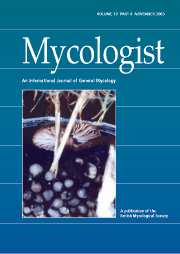Crossref Citations
This article has been cited by the following publications. This list is generated based on data provided by
Crossref.
2000.
21st Century Guidebook to Fungi.
p.
85.
Watkinson, Sarah
Bebber, Dan
Darrah, Peter
Fricker, Mark
Tlalka, Monika
and
Boddy, Lynne
2006.
Fungi in Biogeochemical Cycles.
p.
151.
Tuszynska, Sandra
Davies, Danielle
Turnau, Katarzyna
and
Ashford, Anne E.
2006.
Changes in vacuolar and mitochondrial motility and tubularity in response to zinc in a Paxillus involutus isolate from a zinc-rich soil.
Fungal Genetics and Biology,
Vol. 43,
Issue. 3,
p.
155.
Lamour, Angelique
Termorshuizen, Aad J.
Volker, Dine
and
Jeger, Michael J.
2007.
Network formation by rhizomorphs of Armillaria lutea in natural soil: their description and ecological significance.
FEMS Microbiology Ecology,
Vol. 62,
Issue. 2,
p.
222.
Ashford, A. E.
and
Allaway, W. G.
2007.
Biology of the Fungal Cell.
Vol. 8,
Issue. ,
p.
49.
Cohen, Jonathan D
McClure, Samuel M
and
Yu, Angela J
2007.
Should I stay or should I go? How the human brain manages the trade-off between exploitation and exploration.
Philosophical Transactions of the Royal Society B: Biological Sciences,
Vol. 362,
Issue. 1481,
p.
933.
Shea-Brown, Eric
Gilzenrat, Mark S.
and
Cohen, Jonathan D.
2008.
Optimization of Decision Making in Multilayer Networks: The Role of Locus Coeruleus.
Neural Computation,
Vol. 20,
Issue. 12,
p.
2863.
Zhuang, Xueying
Tlalka, Monika
Davies, Danielle S.
Allaway, William G.
Watkinson, Sarah C.
and
Ashford, Anne E.
2009.
Spitzenkörper, vacuoles, ring-like structures, and mitochondria of Phanerochaete velutina hyphal tips visualized with carboxy-DFFDA, CMAC and DiOC6(3).
Mycological Research,
Vol. 113,
Issue. 4,
p.
417.
Díaz, Brenda Hildeliza Camacho
Aparicio, Antonio Jiménez
Chanona-Pérez, José Jorge
Calderón-Domínguez, Georgina
Alamilla-Beltrán, Liliana
Hernández-Sánchez, Humberto
and
Gutiérrez-López, Gustavo F.
2010.
Morphological characterization of the growing front of Rhizopus oligosporus in solid media.
Journal of Food Engineering,
Vol. 101,
Issue. 3,
p.
309.
Iordache, Virgil
Kothe, Erika
Neagoe, Aurora
and
Gherghel, Felicia
2011.
Diversity and Biotechnology of Ectomycorrhizae.
Vol. 25,
Issue. ,
p.
255.
Wu, Qiang-Sheng
and
Srivastava, Anoop Kumar
2012.
Advances in Citrus Nutrition.
p.
169.
Shimizu, Takeo
Ito, Tsutae
and
Kanematsu, Satoko
2012.
Transient and multivariate system for transformation of a fungal plant pathogen, Rosellinia necatrix, using autonomously replicating vectors.
Current Genetics,
Vol. 58,
Issue. 3,
p.
129.
Heaton, Luke L. M.
López, Eduardo
Maini, Philip K.
Fricker, Mark D.
and
Jones, Nick S.
2012.
Advection, diffusion, and delivery over a network.
Physical Review E,
Vol. 86,
Issue. 2,
Watkinson, S.C.
and
Eastwood, D.C.
2012.
Vol. 78,
Issue. ,
p.
121.
Bowman, Emma Jean
and
Bowman, Barry J.
2014.
Cellular and Molecular Biology of Filamentous Fungi.
p.
179.
Raja Beharelle, Anjali
Polanía, Rafael
Hare, Todd A.
and
Ruff, Christian C.
2015.
Transcranial Stimulation over Frontopolar Cortex Elucidates the Choice Attributes and Neural Mechanisms Used to Resolve Exploration–Exploitation Trade-Offs.
The Journal of Neuroscience,
Vol. 35,
Issue. 43,
p.
14544.
Koen, Renico
and
Engelbrecht, Andries P.
2017.
Maze exploration using a fungal search algorithm.
p.
40.
Cohen, Jonathan D.
2017.
The Wiley Handbook of Cognitive Control.
p.
1.
Koen, Renico
and
Engelbrecht, Andries P.
2017.
Maze exploration using a fungal search algorithm.
p.
46.
Beidler, Katilyn V.
and
Pritchard, Seth G.
2017.
Maintaining connectivity: understanding the role of root order and mycelial networks in fine root decomposition of woody plants.
Plant and Soil,
Vol. 420,
Issue. 1-2,
p.
19.

